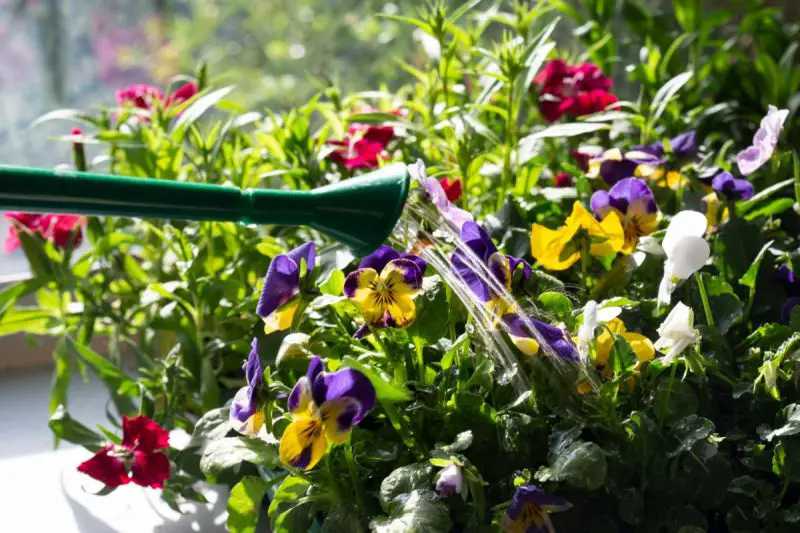Pansies are beloved cool-weather flowers that brighten gardens with their vivid colors and friendly faces. They thrive in both containers and garden beds, making them a favorite among beginner and experienced gardeners alike. However, many people struggle to determine how often to water pansies properly. Watering too frequently can cause root rot, while too little moisture leads to drooping leaves and faded blooms.
Understanding the right watering schedule is essential to keeping pansies healthy and blooming longer. Factors like soil quality, sunlight exposure, temperature, and container type all influence how often they need water. With consistent yet balanced watering, pansies develop strong roots, lush foliage, and vibrant flowers that last through the season. This guide will show you exactly how to water pansies for the best growth and color all year long.
Understanding Pansy Watering Needs

To truly understand pansy watering needs, you must first recognize how these charming flowers grow. Pansies are cool-season bloomers with delicate, shallow roots that depend on consistent moisture. They cannot tolerate prolonged dryness, which causes leaves to wilt and buds to drop. However, they are equally vulnerable to overwatering, which leads to root rot and fungal infections. The best approach is to keep the soil evenly moist, allowing it to dry slightly between waterings without ever becoming completely dry.
The ideal soil for pansies is loose, well-draining, and enriched with organic material. Compost, leaf mold, or peat moss can help maintain the perfect balance between water retention and drainage. Avoid compacted or heavy clay soils, which hold excess moisture and deprive roots of oxygen. On the other hand, sandy soil dries out too fast, forcing you to water more often. When properly amended, the soil should feel damp to the touch but never soggy. Healthy roots depend on a steady flow of air and moisture, creating a strong foundation for lush growth and extended blooming.
Environmental conditions such as sunlight, temperature, and wind also influence watering needs. During cool, cloudy weather, pansies need less water because evaporation slows. In warmer, breezy conditions, the soil dries faster, and plants may need daily attention. Regularly checking soil moisture is essential. Insert your finger into the soil about an inch deep; if it feels dry, water thoroughly until the soil is evenly moist. Understanding these factors allows you to adapt your watering habits and provide the perfect balance that keeps pansies thriving and blooming beautifully through every season.
Factors That Influence How Often to Water Pansies
Soil Type and Drainage
Soil composition is one of the most significant factors determining how often you should water pansies. These delicate flowers thrive in soil that remains evenly moist yet never soggy. Heavy clay soil tends to hold water too long, suffocating roots and causing rot, while sandy soil drains too quickly, leaving pansies dehydrated. The ideal environment is loamy soil enriched with compost, peat moss, or leaf mold, which helps retain moisture while maintaining good drainage. This balance encourages steady hydration and allows the roots to breathe freely.
Proper drainage is essential to prevent stagnant water from accumulating around the roots. Always ensure that flower beds and containers have enough drainage holes to let excess water escape. If your garden soil feels compacted, gently loosen it with a hand fork before watering to improve airflow. In containers, use a lightweight potting mix made for flowering plants to keep the balance between air and moisture. Adding a thin layer of mulch around the base of your pansies can also help regulate soil temperature and reduce water loss through evaporation, keeping your plants consistently hydrated and healthy.
Temperature and Weather Conditions
Temperature and weather patterns directly affect how often pansies should be watered. In cool, cloudy weather, moisture remains in the soil longer, allowing for less frequent watering. But during warm, sunny periods, water evaporates quickly, and pansies may need watering once a day to avoid wilting. High heat stresses the plant, making it vital to water early in the morning when temperatures are lower. This timing allows moisture to penetrate the soil deeply before the day’s heat intensifies, minimizing evaporation and ensuring roots stay hydrated.
Rainfall patterns also play a major role in setting the watering schedule. Regular light rain reduces the need for additional watering, while long dry spells demand close monitoring. Windy days increase evaporation even further by drying out both soil and foliage. Pansies grown in exposed garden areas may require extra attention during these conditions. Observing local climate trends and adjusting your watering routine accordingly helps maintain consistent soil moisture. By adapting to changing weather patterns, gardeners can ensure their pansies stay vigorous, colorful, and blooming beautifully throughout the growing season.
Container vs. Ground Planting
The location where your pansies grow determines how often they need water. Pansies planted directly in the ground benefit from deeper soil layers that retain moisture for longer, meaning they typically need watering every few days. In contrast, pansies in containers dry out much faster due to increased air circulation and heat exposure around the pot. During warm or windy conditions, you might need to water them daily—or even twice a day—to prevent drooping or browning leaves. The smaller the pot, the quicker it loses moisture, so size matters when maintaining healthy pansies.
To improve moisture retention, use larger containers filled with rich, loamy potting soil. Adding organic material helps hold water while keeping the mix well-aerated. You can also place a layer of mulch or sphagnum moss on top to slow evaporation. Always water thoroughly until you see it draining from the bottom to ensure that the entire root system receives adequate moisture. Checking the soil daily by touch helps prevent over- or underwatering. By understanding these environmental differences, gardeners can fine-tune their watering routines and keep pansies blooming abundantly in both pots and garden beds.
Seasonal Watering Guide for Pansies
Spring Watering
Spring is the season when pansies burst into full growth after winter dormancy. During this period, consistent watering plays a key role in supporting strong roots and abundant blooms. As temperatures begin to rise, the soil tends to dry faster, so pansies generally need watering about two to three times per week. The goal is to keep the soil consistently moist but never soggy. Morning watering is ideal since it allows moisture to soak in before the afternoon sun evaporates it. Avoid watering late in the day to prevent fungal issues that can occur when foliage stays damp overnight.
In regions with unpredictable spring rains, always check soil moisture before watering again. Stick your finger about an inch into the soil—if it feels dry, it’s time to water. Mulching around the base of your pansies helps retain moisture and stabilize soil temperature. This practice reduces the need for frequent watering and keeps roots healthier. Consistent hydration during spring sets the foundation for vibrant flowers that will continue blooming into early summer, giving your garden a lush and colorful start to the growing season.
Summer Watering
Summer is the most demanding season for pansies because of the higher temperatures and stronger sunlight. During hot weather, pansies may require daily watering, especially if they are grown in containers or hanging baskets that dry out quickly. It’s essential to water deeply so that moisture reaches the root zone, helping the plants stay cool and hydrated throughout the day. Early morning watering is best since it minimizes evaporation and gives the plants time to absorb moisture before the heat peaks. Avoid watering during the hottest hours, as rapid evaporation can cause water stress and leaf scorch.
If summer temperatures consistently exceed 80°F (27°C), pansies often struggle and may temporarily stop blooming. To protect them, move containers to partial shade or use garden fabric to reduce heat exposure. Adding a layer of organic mulch around the plants also helps retain soil moisture and keep the roots cool. Keep an eye on wilted leaves or drooping flowers—these are signs your pansies need immediate watering. By maintaining a steady watering routine and providing some shade, your pansies can survive summer heat and be ready to bloom again once temperatures cool down.
Fall Watering
Fall provides an ideal environment for pansies to flourish, as cooler temperatures and moderate rainfall reduce stress on the plants. During this season, watering frequency can be reduced compared to summer. Pansies usually need watering about two to three times per week, depending on local weather and soil drainage. The key is to keep the soil consistently moist but never soggy. As temperatures drop, pansies shift their energy toward root development, so steady moisture supports strong underground growth. Deep watering encourages roots to spread widely, helping the plants establish before winter arrives.
Even though fall weather is cooler, don’t assume rain alone will meet your pansies’ needs. Check the soil regularly, especially if there are dry spells or windy days that can cause moisture loss. When watering, aim for the base of the plant to prevent wet foliage, which can lead to fungal issues in cooler, damp conditions. Mulching around the base helps conserve water and regulate soil temperature. With the right balance of moisture and good air circulation, pansies thrive in fall, producing rich color that lasts until the first frost.
Winter Watering
During winter, pansies enter a slower growth phase, but they don’t go completely dormant. These hardy flowers can tolerate light frost and even brief snow cover, yet consistent moisture remains crucial for survival. The soil should stay slightly damp to protect the roots from freezing and drying out. Water pansies deeply once every 7 to 10 days when the ground isn’t frozen. This helps maintain root hydration during cold spells. Avoid watering when temperatures are below freezing, as ice can damage root tissues. Well-draining soil is essential since soggy conditions in winter can lead to root rot and fungal diseases.
It’s important to monitor weather patterns carefully during this season. In regions with mild winters, occasional warm days can cause pansies to start growing again, requiring more frequent watering. In contrast, areas with heavy snowfall benefit from natural moisture as snow melts. Adding a layer of mulch around the base helps insulate roots and retain soil moisture. When combined with careful watering and protection from harsh winds, these steps allow pansies to stay healthy through winter and burst back into vibrant bloom once spring arrives.
Common Watering Mistakes to Avoid
Overwatering Pansies
Overwatering is one of the most common and damaging mistakes when caring for pansies. While these flowers appreciate consistent moisture, their roots cannot tolerate waterlogged soil. When pansies sit in excess water, oxygen cannot reach the roots, leading to root rot and stunted growth. Signs of overwatering include yellowing leaves, droopy stems, and soft or blackened roots. Once root rot sets in, recovery becomes difficult, and the plant may eventually die. To prevent this, always ensure the soil drains well and avoid watering too frequently, especially during cool or cloudy weather when evaporation is slower.
To correct overwatering, allow the soil to dry slightly before watering again. Raised beds or containers with drainage holes are ideal for pansies, helping to prevent standing water. Adding organic matter such as compost or peat moss improves soil structure and promotes airflow. Water in the morning to give plants time to dry before nightfall, reducing the risk of fungal diseases. With proper watering habits and soil management, pansies can recover quickly and continue to bloom beautifully throughout the growing season.
Underwatering Pansies
Underwatering pansies can cause stress that quickly affects their growth and bloom quality. These delicate flowers rely on steady moisture to maintain their vibrant petals and lush foliage. When deprived of water, pansies begin to wilt, and their leaves turn dry or brittle. The flowers may fade prematurely, and new buds often fail to open. Prolonged drought conditions weaken the root system, making the plant more vulnerable to pests and temperature fluctuations. Pansies grown in containers dry out even faster than those in garden beds, so they require more frequent attention, especially in sunny or windy locations.
To prevent underwatering, always check the soil’s moisture level before it becomes completely dry. A good rule is to water when the top inch of soil feels dry to the touch. Deep watering encourages roots to grow downward, improving the plant’s resilience during hot or dry weather. Adding mulch around the base of the plant helps retain moisture and reduces evaporation. During warm spells, daily watering may be necessary, particularly for container-grown pansies. With consistent care and close observation, pansies will stay hydrated and reward you with continuous, colorful blooms.
Inconsistent Watering Habits
Inconsistent watering is another common mistake that can hinder pansy health and flowering. These plants thrive on balance, and irregular watering—alternating between too dry and too wet—can cause serious stress. When soil moisture fluctuates, pansies struggle to develop a stable root system. Their leaves may curl or show brown edges, and blooming becomes irregular. Sudden dryness followed by heavy watering can also cause root cracking or fungal growth. Inconsistent care makes it difficult for the plant to absorb nutrients effectively, weakening its overall vigor and bloom production.
To maintain consistency, create a regular watering routine based on weather and soil conditions. Check soil moisture daily during active growth seasons and water as soon as it starts to dry slightly. Early morning watering is best, giving the soil time to absorb moisture before the heat of the day. For container-grown pansies, monitor them more often since pots dry faster than garden soil. Using mulch or organic compost helps maintain a stable level of moisture, reducing fluctuations. By keeping your watering schedule predictable, pansies can grow stronger roots and produce long-lasting, vibrant flowers throughout the season.
Best Watering Techniques for Healthy Pansies
Watering pansies correctly is key to ensuring lush growth and prolonged flowering. The best technique is deep, infrequent watering rather than shallow, frequent sprinkling. Deep watering encourages roots to grow downward, making the plants more resilient to heat and dry spells. To do this effectively, water slowly at the base of each plant until the soil feels moist about six inches deep. Avoid overhead watering because wet leaves can lead to fungal diseases such as powdery mildew or leaf spot, especially during humid weather. Always water early in the morning so the foliage can dry out by evening.
For container-grown pansies, watering methods must be more precise. Containers tend to dry out faster due to limited soil volume, so check moisture levels daily. When the top inch of soil feels dry, it’s time to water thoroughly until excess liquid drains out from the bottom. Using self-watering containers or adding water-retaining crystals to the soil mix can help maintain consistent moisture levels. Make sure containers have proper drainage holes to prevent root rot.
In garden beds, applying mulch around the base of the plants keeps soil moisture stable and reduces evaporation. Organic materials like shredded bark, straw, or compost not only conserve water but also enrich the soil as they decompose. Pairing these watering methods with well-draining soil and regular observation creates the perfect balance for healthy, blooming pansies. With these techniques, your pansies will reward you with vibrant colors and continuous growth throughout the season.
Watering Pansies in Containers vs. Ground Beds
Watering Pansies in Containers
Pansies grown in containers require more frequent and careful watering than those planted in garden beds. Because containers hold limited soil, they dry out much faster, especially under direct sunlight or strong wind. The key to success is maintaining consistent moisture without allowing the soil to become waterlogged. Check the soil daily by touching the surface—if the top inch feels dry, water thoroughly until moisture drains from the bottom. Deep watering ensures that the entire root system receives hydration and prevents surface-level roots from forming.
To improve water retention, use a high-quality potting mix enriched with compost or coco peat. Adding perlite or coarse sand enhances drainage and prevents root rot. Containers should always have drainage holes to allow excess water to escape. During hot weather, pansies in pots may need watering once or even twice a day. Self-watering containers or saucers can help regulate moisture levels more effectively. Positioning the containers in areas with partial shade also reduces water loss and helps keep the plants vibrant longer. With consistent care, container-grown pansies can remain lush and colorful for months.
Watering Pansies in Ground Beds
Pansies planted directly in garden beds benefit from more stable moisture conditions compared to those in containers. However, proper watering is still essential to maintain strong root systems and continuous blooming. Deep watering every two to three days is usually sufficient, but frequency should be adjusted depending on rainfall and soil type. Loamy, well-draining soil is ideal because it holds moisture while allowing excess water to flow away easily. Sandy soils may require more frequent watering, while clay soils should be watered less to prevent compaction and root suffocation.
For the best results, water early in the morning so the plants can absorb moisture before the day heats up. Avoid overhead watering, as wet leaves can attract fungal diseases. A soaker hose or drip irrigation system works best for ground beds, delivering water directly to the roots while conserving resources. Mulching around the base of pansies also helps retain soil moisture, reduce evaporation, and suppress weeds. Consistent watering combined with nutrient-rich soil ensures that pansies in garden beds produce strong stems, healthy leaves, and abundant blooms throughout the growing season.
Signs Your Pansies Need More or Less Water
Recognizing the signs of improper watering is essential for keeping pansies healthy and full of blooms. When pansies don’t get enough water, they quickly show visible distress. Leaves begin to wilt and lose their bright color, while stems become limp. The foliage may turn brown or develop crispy edges, and blossoms often fade or drop early. In very dry conditions, the soil looks pale, cracked, or may pull away from the pot’s edges. Prolonged dryness weakens the roots, limiting nutrient absorption and preventing new growth. Deep, consistent watering helps restore vitality and strengthens the plant’s overall resilience.
Overwatering, however, poses an equally serious problem. Pansies that sit in constantly soggy soil often develop yellowing leaves, mushy stems, and drooping foliage despite being wet. Root rot is a common result, producing an unpleasant smell and stunted growth. You may also notice fungus or mold forming on the soil surface. If these symptoms appear, it’s crucial to reduce watering and improve drainage immediately. Loosening compacted soil or transferring the plants to well-draining containers can help them recover more quickly and prevent future damage.
Maintaining proper balance is the key to healthy pansies. Always check the top inch of soil before watering and consider temperature, sunlight, and humidity levels. Pansies prefer moist but never waterlogged soil. In warmer climates, they may need watering more frequently, while cooler weather allows for longer intervals between waterings. Consistent monitoring keeps moisture levels stable, encouraging strong roots and vibrant, lasting blooms throughout the growing season.
How Soil Type Affects Pansy Watering Needs
The type of soil where your pansies grow has a powerful influence on how often they need watering. Sandy soils, for example, drain quickly and don’t retain moisture for long. While this prevents root rot, it also means water evaporates fast, requiring more frequent watering to keep pansies hydrated. To improve water retention, gardeners can enrich sandy soil with organic matter like compost or peat moss. This helps the soil hold moisture longer while still allowing proper drainage. Regular deep watering is also important in sandy soil to ensure moisture reaches the root zone instead of staying near the surface.
In contrast, clay soils hold water for extended periods, often to the point of becoming waterlogged. While pansies appreciate steady moisture, excessive wetness can suffocate roots and cause fungal problems. If your garden has heavy clay soil, mix in coarse sand or perlite to improve drainage. Raised beds are also beneficial in such conditions, allowing excess water to flow away more easily. Water pansies less frequently in clay soil but monitor them closely, as they may still need extra hydration during hot or windy days.
Loamy soil, which combines sand, silt, and clay, provides the perfect balance of moisture retention and drainage for pansies. It stays evenly moist without becoming soggy, offering roots a stable growing environment. This type of soil allows for consistent watering every few days, depending on weather conditions. Regardless of soil type, always check moisture depth before watering. Understanding how your soil behaves ensures you can adjust watering frequency appropriately, helping pansies grow stronger and bloom beautifully season after season.
Using Mulch to Maintain Proper Moisture Levels
Mulching is one of the simplest yet most effective ways to help pansies maintain consistent soil moisture. It acts as a natural barrier that slows down evaporation, keeping the soil cool and hydrated even under harsh sunlight. A layer of mulch around the base of pansies helps prevent water loss and keeps the root zone evenly moist, which is essential for steady growth and flowering. Organic materials such as shredded bark, pine needles, straw, or compost are excellent choices because they not only retain moisture but also improve soil quality over time. A layer about two inches thick is ideal—thick enough to be effective but not so heavy that it suffocates the roots. Mulch also moderates soil temperature, preventing stress caused by sudden heat or cold changes.
Besides conserving moisture, mulch offers additional benefits that directly enhance pansy health. It reduces weed growth, minimizing competition for nutrients and water. Mulch also prevents soil from compacting or splashing onto leaves during heavy rain, lowering the risk of soil-borne diseases. However, it’s crucial not to pile mulch directly against the plant’s stems, as that can trap moisture and promote rot. Leave a small gap around each plant’s crown to ensure good airflow. For pansies grown in pots, lighter mulch such as coconut coir, dry leaves, or leaf mold helps retain moisture without overheating the soil.
To maintain mulch effectiveness, check it regularly throughout the growing season. Replace or refresh it when it starts to break down or blow away after strong winds. As organic mulch decomposes, it enriches the soil, improves structure, and boosts overall fertility. This natural process supports strong root systems and reduces the need for frequent watering. With proper mulching, pansies can thrive, producing lush growth and bright, lasting blooms through every season.
FAQ About How Often to Water Pansies
How often should I water pansies?
It depends on soil, container, and climate. Generally water deeply two to three times per week in garden beds. Containers may need daily watering in hot weather. Check the top inch of soil; if it feels dry, water. Adjust frequency for rainfall, temperature, and wind. Morning watering reduces disease risk.
How much water should I give each time?
Aim to soak the root zone to about six inches deep. For beds, apply enough water to penetrate deeply without puddling. For containers, water until it drains from the pot’s bottom. This ensures the whole root ball is hydrated and discourages shallow surface rooting.
What are signs of overwatering or underwatering?
Underwatering shows as wilting, dull leaves, and crispy edges. Soil will feel dry and may pull away from container sides. Overwatering causes yellow leaves, soft stems, and foul-smelling soil. Roots may be dark and mushy from rot. Check soil moisture to diagnose and act early.
When is the best time of day to water pansies?
Early morning is best because leaves dry before night. Morning watering reduces fungal disease risk and fuels daytime growth. In extreme heat, a light late-afternoon watering can help. Avoid frequent evening watering in cool, damp climates to prevent mildew.
How should I adjust watering for containers versus ground beds?
Containers dry much faster than beds and need closer monitoring. Use a quality potting mix, larger pots, or self-watering containers to stabilize moisture. Water containers until they drain, then empty saucers. Beds hold moisture longer; water deeply and less often. Mulch helps both settings conserve water.
Conclusion
Keeping pansies healthy and blooming beautifully comes down to consistent, mindful watering. By understanding their moisture needs and adjusting for weather, soil type, and container size, you can prevent both drought stress and root rot. Always water deeply, allow excess to drain, and check soil regularly to maintain the ideal balance. With the right watering habits, your pansies will reward you with vibrant color and extended blooms throughout the growing season — turning your garden or patio into a cheerful display that thrives long after others fade.






